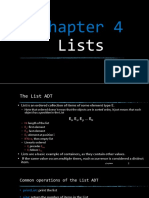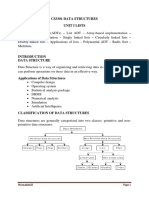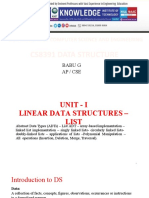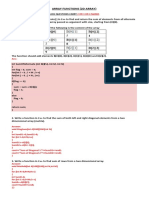0% found this document useful (0 votes)
70 views31 pagesSubject: Data Structures & Algorithms: in The Name of Allah The Most Beneficent The Most Merciful
The document discusses data structures and algorithms, specifically focusing on lists. It provides the following information:
- Lists are a collection of elements of the same type stored in a particular order. Common examples include shopping lists and contact lists.
- Lists can be implemented using arrays or linked memory. Array implementation involves storing elements in consecutive memory locations, while linked implementation connects elements using memory addresses.
- Key list operations are discussed, such as inserting and removing elements, accessing elements by position, and determining the length of the list. Implementing these operations for both array-based and linked lists is also covered.
Uploaded by
Abdullah JuttCopyright
© © All Rights Reserved
We take content rights seriously. If you suspect this is your content, claim it here.
Available Formats
Download as PPT, PDF, TXT or read online on Scribd
0% found this document useful (0 votes)
70 views31 pagesSubject: Data Structures & Algorithms: in The Name of Allah The Most Beneficent The Most Merciful
The document discusses data structures and algorithms, specifically focusing on lists. It provides the following information:
- Lists are a collection of elements of the same type stored in a particular order. Common examples include shopping lists and contact lists.
- Lists can be implemented using arrays or linked memory. Array implementation involves storing elements in consecutive memory locations, while linked implementation connects elements using memory addresses.
- Key list operations are discussed, such as inserting and removing elements, accessing elements by position, and determining the length of the list. Implementing these operations for both array-based and linked lists is also covered.
Uploaded by
Abdullah JuttCopyright
© © All Rights Reserved
We take content rights seriously. If you suspect this is your content, claim it here.
Available Formats
Download as PPT, PDF, TXT or read online on Scribd
/ 31




































































































